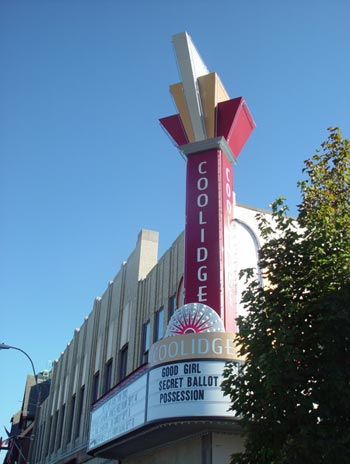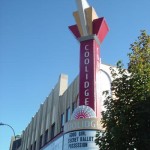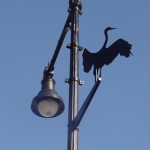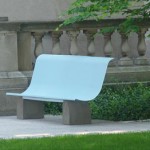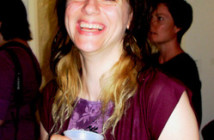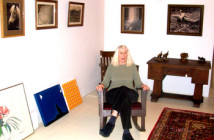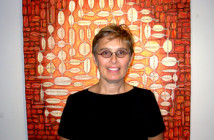November 24, 2005
Settling into a booth for a Beer and Burger session, Mark Lee Favermann, produced a series of glossy images of his latest project, an installation of silhouettes of 20 birds created over the past couple of years as a logo and gateway for the transition from Boston to Brookline at Audubon Circle. As is often the case in the field of urban design, much of the work involved proposal writing, permissions, design and the actual fabrication. It implies the kind of patience, multi tasking, and understanding of political process that separates the field from an artist in a studio.
So just what exactly is the difference between art and design? What is the hands on or art aspect when projects involve computers, drafting and design that is then fabricated by professionals? He answers the rhetorical question by asking just how hands on were the sculptures of Picasso and lots of other famous artists? In the 1970s he thought of himself more as a pure artist when he was creating a series of monumental obelisks or sun dials. That culminated in a one person show at OK Harris Gallery. But it was also a turning point away from fine arts per se to the aspects of urban and environmental design with a concentration of working with sports events; including being selected to design the “look” for the 1996 Centennial Olympic Games in Atlanta.
There was a lot of ground to cover including the manner in which our lives and careers in the arts had intersected since the 1970s when for four years, 1972-1976, he was Secretary General for the Boston Visual Artists Union, a force in its time, and now just a memory. Later, we were colleagues and columnists for Art New England when he wrote on design from 1988 to 2003. Our stints ended with new ownership when a number of long term editors were let go. But we have stayed in close contact primarily through e mail dialogues.
Both personally and professionally, this is a time of difficulty. In general, the design field is tough and highly competitive. There has been steady work but not enough large and well compensated projects. There was a general slow down after 9/11 but eventually a steady increase in the number and quality of commissions and projects. This year, his daughter, Evan, a brilliant student athlete at Brookline High School, has entered her freshman year at Harvard. Mark glows when he talks about her brilliance, talent and character. Most of all that, she is a “good kid.” But this moment also marks the end of his marriage to Barbara, a realtor, and the daunting process of dividing assets.
Overall, I found him in good spirits and highly energized. A time of moving on to new prospects and creating distance from years of conflict. I was interested to learn just how one carves out such a complex life in art and design. It was surprising to learn that he is the son of a superintendent of parcel post who grew up in Norfolk, Virginia. His grandfather came to Virginia (1906) in the hope of striking it rich during the 300th anniversary of the founding of Jamestown. He had served in the Czar’s army and would pursue the immigrant’s dream of a pot of gold. At one point, he went into the Nickelodeon business and early silent pictures, but, “he didn’t think it was a good idea.” Oh well.
“I always drew and painted as a child,” Mark said. “During the 1960s I studied at Norfolk State University under the prominent black artist A.B. Jackson. He was the son of an Irish mother and black father and earned two degrees from Yale in the mid-1950s.” Jackson invited Mark and other high school kids to play with new media such as acrylic and collage. He also studied with Ray Prohaska, who was born in 1901, in Muo, Montenegro. He had been an illustrator for Colliers, Saturday Evening Post, McCall’s, Redbook, Good Housekeeping and Ladies Home Journal. “He worked in a semi-abstract illustrational style,” he said. “Most of all he taught me about the importance of professionalism and deadlines when designing posters, prints and illustrations.” They were skills that would prove to be very useful as he developed professionally. He went on to work as his assistant.
From 1965 to 1969 he earned an undergraduate degree at Washington and Lee University in Virginia. It is a school noted for its Southern gentlemen of which he was hardly typical. From there he matriculated to a master’s program in design at the University of Virginia. Just as he was studying for exams he was drafted and underwent basic training at Fort Knox. It was here that as a Jewish GI he got “religious” ending up as an assistant to a Chaplin. Through the highest test scores in the history of his battalion he ended up in Natick, Mass. Instead of serving in Vietnam he was a lab assistant for the U.S. Army Research Institute of Environmental Medicine. This brought him to the Boston area where he has lived ever since. After a discharge he enrolled in the graduate program of the Harvard University School of Design which combined architecture and urban design. He was a fellow at the Center for Advanced Visual Studies at MIT from 1976-1977 and again in 1994-1995.
“I attended the second meeting of the Boston Visual Artists Union in 1971,” he recalled. It was an exciting time for the arts in Boston.
Back then, I was the art critic for Boston After Dark which later evolved as the Boston Phoenix. The Boston galleries were just beginning to take an interest in the emerging generation of artists following a then aging group of Boston Expressionists. One of the best galleries at the time, run by Phyllis Rosen and Joan Stoneman (later Sonnabend), teamed with Portia Harcus and Barbara Krakow, to open a large, alternative warehouse space, Parker 470, which was steps from Huntington Avenue and the Museum of Fine Arts. I proposed a series of evenings to discuss issues of contemporary art. This culminated in the forming of the BVAU and one of its first acts was to invite Perry Townsend Rathbone, then the director of the MFA, to step across the street and address a meeting of artists. The house was packed when a nervous Rathbone, who believed that the only good artists were dead ones, faced an angry audience demanding change. Not long after, the MFA hosted its first contemporary show “Elements” guest curated by Virginia Gunter. At the press conference, I asked Rathbone when the museum would appoint a contemporary curator. I was a staff critic for the Herald Traveler when Rathbone personally called to inform me of the appointment of Kenworth Moffett as the first curator for contemporary art.
It was a lively period and through the BVAU Mark was in the thick of it. For a time, the group occupied spectacular gallery space, with a sweetheart rental, opposite City Hall Plaza in the heart of Boston. With gallerist Helen Schlein he negotiated the deal, as well as supervised the construction and fundraising for the build out. They staged terrific exhibitions and pursued ambitious programming and advocacy for artist rights. It was one of the most progressive such organizations in the country. Mark describes it as a somewhat thankless job providing “group therapy for 1500 artists.” In 1975, he was hired as Director of Visual and Environmental Arts for the City of Boston. It was a great title but came with no money and little authority so he walked away after ten and a half months. It was one of those classic might have been jobs. He instead focused on making his own urban art culminating in that OK Harris show in 1976. It proved to have disappointing results and few prospects so that led to the decision to concentrate on design. He created signage and design concepts for hospitals, schools and sports events. The work was good for the next several years until the economic setback of 1989.
In the Spring of 1992, he created the “look” for the World University Games in Buffalo, New York. It is the second largest, multi sport event in the world. “When I got that project I set my sites on designing for the Olympics,” he recalled. By then, he had worked for Disney and Universal Studios as well as other major clients so he was ready for something big. “Some 493 firms applied and from that they selected 80 to answer 100 questions,” he recalled. “Two months later I was invited to come on my own dime, it cost me $2,000 out of my pocket, to present competing against much more established firms as a finalist. This was the big leagues. For the presentation I spread out 50 banners I had designed and from 1000 slides I culled down to a presentation of 80 images. From the Buffalo project my sister had taped a sequence on me that ran on ESPN. I could never have afforded to buy the rights to the tape. So that was a part of my presentation. Ultimately, they chose five firms and paid us the largest fee so far in my career. I provided the urban design, banners, logo and maps. I had a staff of 21 people compared to the seven or eight I employed during the 1980s. The follow up work from that provided about double the original fees. Also I gave 20 lectures to major institutions. Despite all that exposure I got no Boston press. Later I suffered huge post project blues. There was no real follow-up. More media coverage, particularly here, would have helped. There was also a lot of scandal associated with that event. After that, I went after other sports events including designing the “look” for the 1999 Ryder Cup at the Brookline Country Club. In 2000, I designed for the NCAA Final Four in Indianapolis and consulted for the 2001 US Track and Field events at Madison Square Garden. In 2002, I was a consultant to a Canadian firm for the Commonwealth Games.”
He has been a consultant over the past four years for the Boston Red Sox including a Ted Williams Tribute and Opening Day festivities. There has been a great range of other projects from college football bowl events and projects for the athletic departments of Harvard University, Boston College, Boston University and Providence College. He was one of the only local firms to work with the Democratic National Convention when it was held in Boston. He created giant banners for the opening night of the Boston Bruins. Working with a public transportation engineering firm he is creating signage and identity for a number of stops in the Boston area for charter buses and duck tours.
Just how would you describe what you do I asked? “I brand cities and provide signatures to urban areas, sports events and institutions,” he replied. He has been asked to write a scholarly paper on his concepts for a leading journal in the field.
Right now, he would like to get back to where he was in the beginning as a sculptor and creating art for public places. He is excited about the Audubon Circle pieces and they are about to be the topic of an exhibition at Boston City Hall. There is a major gallery in negotiation. And one of his most delightful projects was the art deco marquee for the Coolidge Corner Theatre. It was pro bono work but he now has a lifetime movie pass and can get into games at Fenway Park. Nice perks, but still, you have to pay the rent and put the kid through college. While there was a rough patch to navigate in the sharply down, but now recovering economy of the Bush administration, he states that, “The future is beginning to glow if not brightly at least with a little more warmth.”
Links:
Favermann Design
All images are courtesy of the artist.

